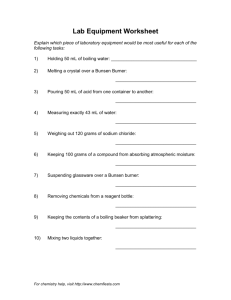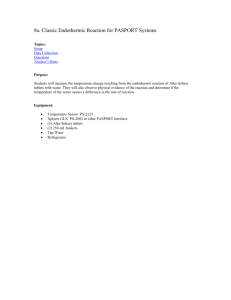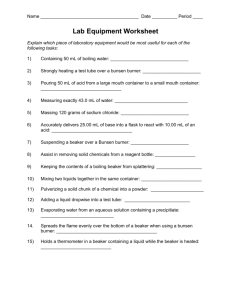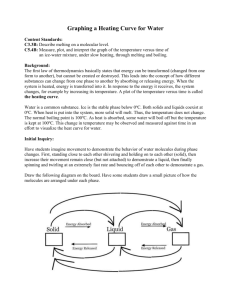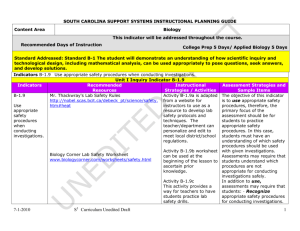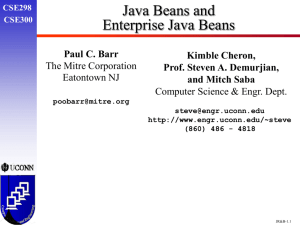ACTIVITY B-1
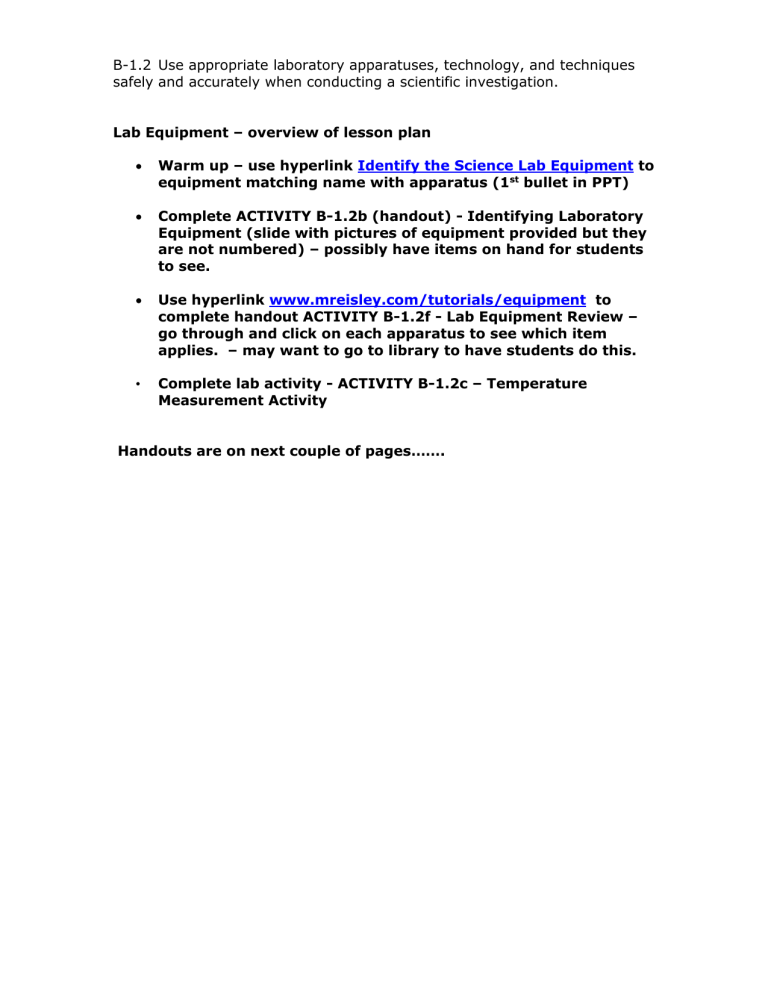
B-1.2 Use appropriate laboratory apparatuses, technology, and techniques safely and accurately when conducting a scientific investigation.
Lab Equipment – overview of lesson plan
Warm up – use hyperlink Identify the Science Lab Equipment to equipment matching name with apparatus (1 st bullet in PPT)
Complete ACTIVITY B-1.2b (handout) - Identifying Laboratory
Equipment (slide with pictures of equipment provided but they are not numbered) – possibly have items on hand for students to see.
Use hyperlink www.mreisley.com/tutorials/equipment to complete handout ACTIVITY B-1.2f - Lab Equipment Review – go through and click on each apparatus to see which item applies. – may want to go to library to have students do this.
• Complete lab activity - ACTIVITY B-1.2c – Temperature
Measurement Activity
Handouts are on next couple of pages…….
ACTIVITY B-1.2b - Identifying Laboratory Equipment
Name_______________________Class _____________ Date _______
Identifying Laboratory Equipment
Introduction
Scientists use a variety of tools to explore the world around them. These tools are very important in the advancement of science. Scientists have to know which tools to use to solve the problems on which they are working. A scientist may use something as simple as a metric ruler to measure the length of a salamander, or a complex computer to analyze large amounts of data concerning a population of salamanders.
You will learn about the some of the tools that a biologist might use to carry out an investigation and how to identify them.
Problem
What are the names and functions of some of the pieces of laboratory equipment found in a typical biology laboratory?
Pre-Lab Discussion
Read the following questions before you begin to observe the laboratory equipment.
1.
What kinds of measurements might you need to make in the laboratory?
2.
What kinds of equipment would you need for these tasks?
3.
There is a variety of glassware and each can be used for measuring. Why are there several types of glassware marked for measuring?
4.
How might glassware be used differently?
5.
When might you need to use a thermometer in the lab?
ACTIVITY B-1.2b cont. - Identifying Laboratory Equipment
Directions
Using the labeled diagram, identify each piece of laboratory equipment.
1.
14.
15.
16.
17.
18.
19.
20.
21.
8.
9.
10.
11.
12.
13.
2.
3.
4.
5.
6.
7.
ACTIVITY B-1.2b cont. - Identifying Laboratory Equipment
ANSWERS
Directions
Using the labeled diagram, identify each piece of laboratory equipment.
1. Triple-beam balance
2. Beaker
3. Bunsen burner
4. Microscope slide cover slip
5. Thermometer
6. Graduated cylinder
7. Dropper pipette
8. Tweezers/ forceps
9. Funnel
10. Goggles
11. Magnifying glass
12. Light Microscope
13. Dissection Pan
14. Petri Dish
15. Dissection Probe
16. Test Tube Rack
17. Test Tube
18. Metric Ruler
19. Dissection Scalpel
20. Dissecting Scissors
21. Microscope Slide
1 2 3 4 5
6 7 8 9
10 11 12 13
14 15 16 17
18 19 20 21
ACTIVITY B-1.2b cont. - Identifying Laboratory Equipment
Discussion
1. Which laboratory tools can be used to magnify small objects so they can be seen more easily?
2. Which laboratory tools are useful when looking at the inside of a plant cell?
3. What tool or tools would you use to make each of the following measurements? a. width of your textbook b. mass of an apple c. temperature of the water in a pot of boiling water d. amount of water in the bottom of a small glass
4. How do laboratory tools improve the observations made by a scientist?
5. List five laboratory tools that are not part of questions # 1, 2, 3, or 4.
What is the function of each?
ACTIVITY B-1.2c – Temperature Measurement Activity
Experiment 1: The Effects of Temperature on Rate of a Reaction
Ideas
1. In order for a chemical reaction to occur, the particles, atoms or ions, which are REACTANTS, must physically come into contact with one another.
Anything that increases the frequency of these encounters will increase the rate at which PRODUCTS are formed.
2. The rate of a chemical reaction can be increased by increasing the temperature of these reactants.
My predictions:
Using hot water out of the tap, the rate of reaction will be _________ times faster than at 0 degrees C.
Materials:
Note: All experiments should be done using original formula effervescent
Alka-Seltzer.
6 Clear beakers
Graduated Cylinder
Thermometer, -20 degrees C to 110 degrees C
3 Alka-Seltzer tablets
Stopwatch
Mortar and pestle
Source of hot water
Ice cubes
Graph paper
Procedure:
A. Hot Water
1. Run water from the hot tap until it is as hot as possible. Fill a clear beaker with exactly 240 ml of hot water.
2. Use the thermometer to take the temperature and record it on your data sheet.
3. Remove 1 Alka-Seltzer tablet from its package. Drop it into water.
Measure the time required for tablet to fully dissolve. Be prepared to start and stop on time. The reaction will take less than 15 seconds. Record the time.
B. Room Temperature Water
1. Fill a clear beaker with exactly 240 ml of room temperature or lukewarm water.
2. Use the thermometer to take the temperature and record it on your data sheet.
3. Drop 1 Alka-Seltzer tablet into the water. Measure the time required for the reaction to be completed. Record the time.
C. Cold Water
1. Fill a clear beaker with 120 ml of water and add enough ice to adjust the level to 240 ml. Stir the ice water for about 15 seconds with a stirring rod so the temperature will become uniform throughout the beaker.
2. Use the thermometer to take the temperature and record it on your data sheet. (Leave the ice cubes in the water!)
3. Drop 1 Alka-Seltzer tablet into the water. Measure the time required for the reaction to be completed. Record the time.
Observations:
Water Temperature - Time for Reaction to be Completed
Hot Tap _____ degrees C ______ Seconds
Room temperature ______ degrees C _____ Seconds
Ice Water _____ degrees C _____ Seconds
Analysis:
Graph your data points (water temperature vs. time to fully dissolve) to show the effect of temperature on Rate of Reaction. Remember to title your graph and label the x- and y – axis appropriately.
Summary:
As the temperature increases, the rate of reaction __________________.
Questions:
1. At a temperature of 10 degrees C, it would take ______ seconds for 1
Alka-Seltzer tablet to react with 240 ml of water.
2. If the temperature is doubled from 20 degrees C to 40 degrees C, the time for the rate of reaction ______by approximately _______.
3. Using hot tap water, the rate was _____ times faster than at 0 degrees C.
ACTIVITY B-1.2f - Lab Equipment Review
Indentify which piece of laboratory equipment would be most useful for each of the following tasks:
1) Holding 50 mL of boiling water:
_______________________________________
2) Measuring the temperature of a water bath:
_________________________________
3) Pouring 50 mL of acid from one container to another:
______________________
4) Measuring exactly 43mL of water:
_____________________________________
5) Weighing out 120 grams of sodium chloride:
_____________________________
6) Suspending glassware over a Bunsen burner:
_____________________________
7) Removing chemicals from a reagent bottle:
______________________________
8) Keeping the contents of a boiling beaker from splattering:
___________________
9) Mixing two liquids together:
__________________________________________
ACTIVITY B-1.2f - Lab Equipment Review
Lab Equipment Worksheet – Answers
Explain which piece of laboratory equipment would be most useful for each of the following tasks:
1) Holding 50 mL of boiling water: beaker
2) Measuring the temperature of a water bath: thermometer
3) Pouring 50 mL of acid from one container to another: funnel
4) Measuring exactly 43mL of water: graduated cylinder
5) Weighing out 120 grams of sodium chloride: balance
6) Suspending glassware over a Bunsen burner: ring stand
7) Removing chemicals from a reagent bottle: spatula or scoopula
8) Keeping the contents of a boiling beaker from splattering: watch
glass
9) Mixing two liquids together: stirring rod

